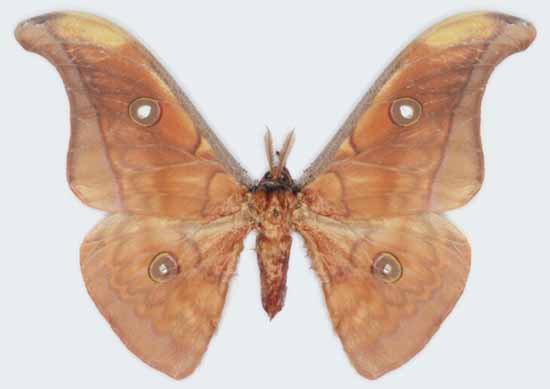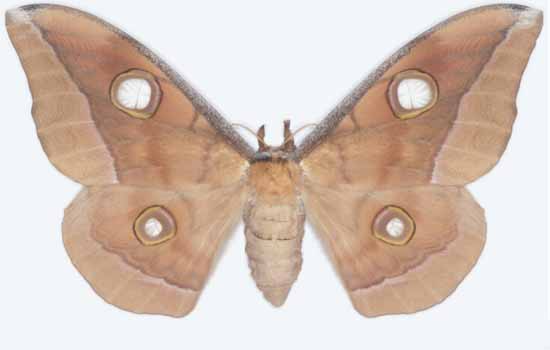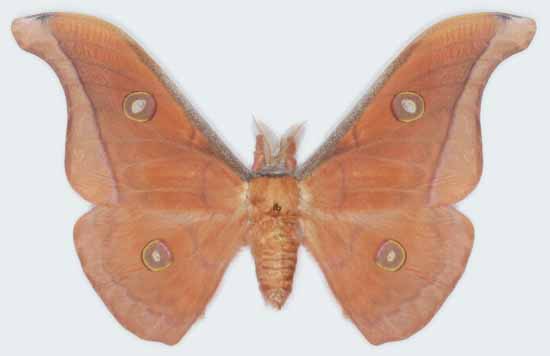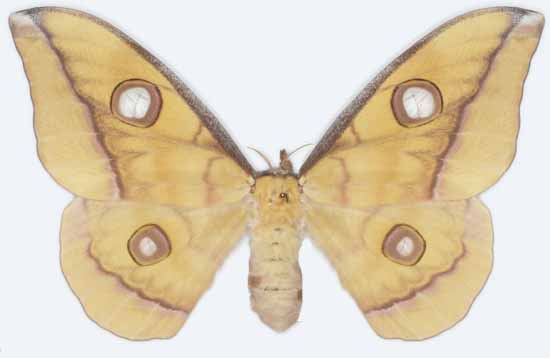Antheraea rumphii rumphii
C. Felder 1861

Antheraea rumphii rumphii male.
TAXONOMY:Superfamily: Bombycoidea, Latreille, 1802 |
"Eyes for You" |

TAXONOMY:Superfamily: Bombycoidea, Latreille, 1802 |
"Eyes for You" |

"The morphology of the preimaginal instars of A. r. rumphii fits the paphia-group of the nominotypical subgenus Antheraea.
A. r. rumphii most probably is not a taxon of the paphia-subgroup but belongs to the frithii-subgroup. The larva of A. r. rumphii also shows characteristics, which are known for the helferi species-group (sensu Nässig 1991).
Descriptions of immature stages:
Ovum oval shaped, length 3.5 mm, width 2.8 mm, height 1.9 mm, chorion approximately 0.06 mm thick. Coloration pale beige with two dark brown rings (width 0.2-0.3 mm) extending around greatest circumference. Ovum covered with a light brown secretion for affixing egg to substrate. Chorionic sculpturing conspicuous, unsymmetrically pentagonal and hexagonal.
1st instar larva about 6-7 mm long after hatching from egg, ground coloration yellow; each segment with two rings posterior and anterior the transverse rows of scoli, which are laterally black and dorsally mostly brown. Head, legs, spiracles, prothoracic shield, the border of the anal plate black. Anal prolegs with a black triangular patch on the outside. Scoli not much prominent. Subspiracular scoli generally shorter than other. Scoli mostly in 6 longitudinal rows, except for meso- and metathorax with each 8 scoli (basolateral row of scoli present on the thoracic segments), 9th abdominal segment with 4 scoli (on prothorax and 9th abdominal segment subdorsal and subspiracular scoli fused), and posterior end of slender anal plate with 2 scoli. Bases of dorsal scoli fused on 8th abdominal segment. Scoli bearing mostly 5-6 translucent yellow bristles at apex, the prominent scoli of the prothorax and the 9th abdominal segment bearing 10-15 bristles, in latter the higher number of bristles might be result of fused scoli. Bristles on subspiracular scoli relatively long.
2nd instar larva yellowish green, a pale yellow line connecting subdorsal scoli of abdominal segments and continued on the anal prolegs, as usual for the nominotypical subgenus. A brownish black triangular patch at the outside of each anal proleg present in this and following larval instars. Color of anal plate and prothorax slightly paler than the ground color of larva. Prolegs with glossy black rings, legs black, spiracles, and head capsule brownish black. Morphology of the scoli as in previous instar but dorsal and subdorsal orange and subspiracular violet colored. Dorsal scoli of 8th abdominal segment nearly fused but the tips are always well separated with two rings of bristles in this and all following instars. Bristles pale brown, occasionally with black apex. Cuticle covered with numerous conspicuous club-shaped white short hairs in this and all following instars. Dorsally with a few soft hairs on abdominal segments longer than scoli and facing anteriorly.
3rd instar larva yellowish green or green. Anal plate and anal prolegs pale yellowish green; the triangular patch and the border of the anal plate brown. Head capsule and spiracles of 1st to 7th abdominal segments brownish black, those of 8th abdominal segment orange. Prolegs with black-orange-black rings and irregular, long, black bristles. Subspiracular scoli much reduced, turquoise, bearing long brown bristles. Prothoracic scoli orange and slightly longer than other scoli, which are reduced, mostly white with orange base and bristles. Hairs whitish yellow.
4th instar larva not much different from previous instar. Spiracles mostly black, brownish orange in center. Prothoracic scoli highly reduced. Scoli dorsally slightly paler turquoise than laterally. Prolegs without colored rings. Dorsal scoli mostly with a long slender hair. A few slender, thin, long black hairs on the cuticle present.
5th instar larva not much different from previous instar. Ground color pale green, dorsally green, the subdorsal longitudinal stripe pale yellow. Head and legs with a pale or dark brown pattern. Scoli pale grayish blue with short brown or yellow bristles and often with one long slender hair.
6th instar larva uniform pale bluish green. Spiracles orange, black bordered. Head and legs ochre with pale or reddish brown pattern. Subspiracular scoli without bristles, the bristles of other scoli shorter than in previous instar and hairs more soft. In no larval instar any silvery patches or rings (tracheal chamber beneath the cuticle) were present. Mature larva approximately 7 cm long.
Cocoon ovoid in shape, beige colored. As in the frithii[sic]-subgroup and others, covered with a leaf and fixed to the twig by loose silk only; not extraordinarily hard and without strong peduncle as in the Indian A. paphia (Linnaeus, 1758) or its supposed synonym mylitta (Drury 1773) [remarks: presently mylitta is considered being the senior synonym of paphia].
Pupa mostly dark reddish brown or black, abdominal segments lateral and ventral pale brown colored. Length/breadth of male pupa 40/17 mm and of female pupa 44/19 mm. Antennal covers shorter than covers of legs of 3rd thoracic segments. Length/breadth of antennal covers of male 13/6 mm and of female 13,5/5 mm. Rounded cremaster with spines. Head with transparent light-detecting "window" between eye covers." Ulrich Paukstadt
Return to Antheraea Genus
Return to Main Index

